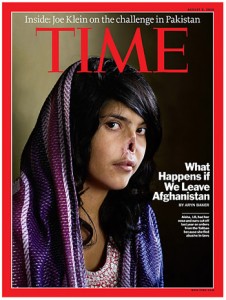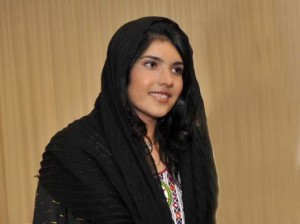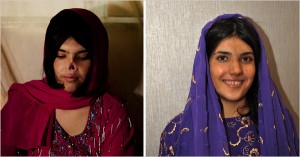 The woman on the cover of Time is Bibi Aisha, an 18-year-old Afghan woman. Time’s online photo gallery — Women of Afghanistan: Living Under the Taliban Threat, which displays an additional image of Aisha — tells her story:
The woman on the cover of Time is Bibi Aisha, an 18-year-old Afghan woman. Time’s online photo gallery — Women of Afghanistan: Living Under the Taliban Threat, which displays an additional image of Aisha — tells her story:
[She] was dragged from her home by the Taliban after running away from her husband. Despite her pleas that her in-laws had been abusive, that they treated her like a slave, that she had no choice but to escape, a Taliban commander said that she must be punished, lest other girls in the village try to do the same thing. Aisha’s family members carried out the punishment: her brother-in-law held her down while her husband sliced off her ears and nose, then left her to die. She is now hidden in a secret women’s shelter, where she was taken after receiving care from U.S. forces.
The lead paragraph in Time’s story on Afghan women and the Taliban repeats Aisha’s story in slightly more dramatic prose:
The Taliban pounded on the door just before midnight, demanding that Aisha, 18, be punished for running away from her husband’s house. Her in-laws treated her like a slave, Aisha pleaded. They beat her. If she hadn’t run away, she would have died. Her judge, a local Taliban commander, was unmoved. Aisha’s brother-in-law held her down while her husband pulled out a knife. First he sliced off her ears. Then he started on her nose.
A worthy cause or “Afghansploitation”?
Richard Stengel, managing editor of Time, discussed the decision to use this “disturbing” image on the cover in an online article and on the Charlie Rose show.
Aisha posed for the picture and says she wants the world to see the effect Taliban resurgence would have on the women of Afghanistan, many of whom have flourished in the past few years. …
I thought long and hard about whether to put this image on the cover of TIME. First, I wanted to make sure of Aisha’s safety and that she understood what it would mean to be on the cover. She knows that she will become a symbol of the price Afghan women have had to pay for the repressive ideology of the Taliban. We also confirmed that she is in a secret location protected by armed guards and sponsored by the NGO Women for Afghan Women.
Stengel anticipates criticism of his use of the image:
I’m acutely aware that this image will be seen by children, who will undoubtedly find it distressing. We have consulted with a number of child psychologists about its potential impact. Some think children are so used to seeing violence in the media that the image will have little effect, but others believe that children will find it very scary and distressing … as “a symbol of bad things that can happen to people.” … I apologize to readers who find the image too strong …. But bad things do happen to people, and it is part of our job to confront and explain them. … I would rather confront readers with the Taliban’s treatment of women than ignore it. I would rather people know that reality as they make up their minds about what the U.S. and its allies should do in Afghanistan.
In his Charlie Rose interview, Stengel explicitly said that Time’s coverage of the story was not intended either to support or oppose America’s continued presence in Afghanistan. That last sentence, however, clearly implies that the treatment of women in Afghanistan should be a deciding factor. How could we not care?
”Do you want to help Aisha or not?
Max Fisher, at The Atlantic Wire, features a number of responses to the cover.
My favorite is from Irin Carmon at Jezebel:
[T]here is an elision here between these women’s oppression and what the U.S. military presence can and should do about it, which in turn simplifies the complexities of the debate and turns it into, “Well, do you want to help Aisha or not?”
Greg Mitchell at The Nation:
I have to ask: In Time’s mission to really “illuminate what is actually happening on the ground” has it ever put on its cover close-up images of 1) a badly wounded or dead U.S. soldier 2) an Afghan killed in a NATO missile strike 3) an Afghan official, police officer or military commander accepting a bribe from a Taliban war lord.
Gulliver at Ink Spots speaks to the exploitation issue (by saying he’s not interested in it) and to the plight of Afghan women as motivation for American policy:
I don’t want to reduce this whole thing to a complaint about the media and the circulation motive, the ethics of making editorial decisions and headline choices out of a drive to sell papers, etc etc, because I don’t find that to be a particularly interesting subject. Will more people pick up this issue because of the disturbing cover image? Probably. Will some people avoid it for the same reason? Probably. Will more people be talking about TIME because of this provocative editorial decision? Certainly, and it strikes me that that’s probably the point.
So I guess if we’re trying to come around to something bigger than a discussion of journalistic ethics, it’s this: should the plight of women (or people in general) under hard-line theocratic rule be driving our policy choices?
There’s also this statement in the New York Times, which ran its own story on Afghan women, the Taliban, and the war.
Although Secretary of State Hillary Rodham Clinton has also pledged that she will not desert Afghan women and that any deal with the Taliban that traded peace for women’s rights was “a red line,” women remain wary.
Just how much of a policy statement should we read into that?
Updates 8/5/10:
Portrait of Pain Ignites Debate Over Afghan War (The New York Times)

Reaction to the Time cover has become something of an Internet litmus test about attitudes toward the war, and what America’s responsibility is in Afghanistan. Critics of the American presence in Afghanistan call it “emotional blackmail” and even “war porn,” while those who fear the consequences of abandoning Afghanistan see it as a powerful appeal to conscience.
Burqas and bikinis (The Guardian, Priyamvada Gopal)
Feminists have long argued that invoking the condition of women to justify occupation is a cynical ploy, and the Time cover already stands accused of it. Interestingly, the WikiLeaks documents reveal CIA advice to use the plight of Afghan women as “pressure points”, an emotive way to rally flagging public support for the war. …
While there exists a colonial tradition of relegating the non-west to the past of the west – and some suggest leaving it to rot in hopelessness – the trendier option involves incorporating Afghans into modernity by teaching them to live in a globalised present. … Sex and the City in the Middle East may have tanked as a movie, but as ideology it has displaced meaningful global feminism. …
In the affluent west itself, modernity is now about dismantling welfare systems, increasing inequality (disproportionately disenfranchising women in the process), and subsidising corporate profits. Other ideas once associated with modernity – social justice, economic fairness, peace, all of which would enfranchise Afghan women – have been relegated to the past in the name of progress. This bankrupt version of modernity has little to offer Afghans other than bikini waxes and Oprah-imitators. A radical people’s modernity is called for – and not only for the embattled denizens of Afghanistan.
What Happens if We Leave Afghanistan?? …Try, What’s Happening on this Cover? (BagNews)
Does Aisha look more like a model whose nose has been photoshopped away?
Isn’t this title [“What Happens if We Leave Afghanistan”] … applying emotional blackmail and exploiting gender politics to pitch for the status quo — a continued U.S. military involvement?
Lust, Devotion, & the Binary Code (The Virginia Quarterly Review)
Not about women in Afghanistan, but in Iran. What happens to sexuality when it’s driven underground?
Despite so much effort by the government to remove sex from the public sphere, it seemed to be on the very air itself. When I had first returned to Iran in 1996, I had been unnerved by a young soldier winking at me on the street. Ten years later, I was combating explicit suggestions from strange men as I went about my business. … [I]n those days [before the Revolution] they [women] had been wearing mini-skirts after all, but now that we were all encased in the hejab, I was surprised to see that not only were the men not put off by the coverings, if anything they were titillated by it.
How Does Stoning Work in Iran? (Slate)
When stonings happen, how do they work? First, you get buried. Iran’s Islamic Penal Code states that men convicted of adultery are to be buried in the ground up to their waists; women, up to their chests. … Stones must be of medium size, according to the penal code: Not so big that one or two could kill the person, but not so small that you would call it a pebble. In other words, about the size of a tangerine. The whole process takes less than an hour.
Update 10/13/10:
Bibi Aisha, Disfigured Afghan Woman Featured On ‘Time’ Cover, Visits U.S. (NPR)
On Saturday, Aisha appeared at a Grossman Burn Foundation fundraiser in a traditional embroidered caftan and a sheer scarf draped over her wavy black hair. It was the first time she’d been seen in public since arriving in the U.S. The radiant 19 year old was wearing a prosthetic nose, something that indicated how she would look when the several reconstructive surgeries are completed. She didn’t speak, but her smile said everything.
Aisha was wearing the kind of nose actors often do for a part. Her goal is still to have a permanent one. But getting there will be a tough slog: she’ll have to have bone and cartilage reconstructed, possibly from flaps of her own skin and several surgeries. But within a year, doctors expect she’ll have a nose that not only completes her face, but that can do what her old nose did — twitch when it itches, smell, even sneeze.
The smile that defies the Taliban: Afghan teenager whose mutilated face shocked the world unveils her new image (The Daily Mail)
She [Aisha] went before the TV cameras to receive the Enduring Heart award at a benefit for the Grossman Burn Foundation – the Los Angeles-based organisation that paid for her surgery.
She was given the award by California first lady Maria Shriver.
Arnold Schwarzenegger’s wife told the audience: ‘This is the first Enduring Heart award given to a woman whose heart endures and who shows us all what it means to have love and to be the enduring heart.’
Aisha, whose surname has not been revealed, replied: ‘Thank you so much.’
Update 12/9/10:
Arrest Made in Afghan Disfigurement Case (New York Times)
Interesting details on recent developments. Father-in-law “took her amputated nose and proudly showed it off around the village.”
Father of mutilated Afghan girl fears attackers will escape law (Guardian)
Father-in-law arrested, but according to Aisha’s father, “It is just a matter of knowing the right person in Uruzgan and you can get out of prison.”
Image source: New York Times
Related links:
The death of Wang Bei: Cosmetic surgery as a moral choice
The problem in Afghanistan is hunger
The enduring benefits of saving children
Novartis gender discrimination verdict: Guilty as charged
Resources:
Image source: Grossman Burn Foundation
Aryn Baker, Afghan Women and the Return of the Taliban, Time, July 29, 2010
Richard Stengel, The Plight of Afghan Women: A Disturbing Picture, Time, July 29, 2010
Richard Stengel & Joe Klein, The Charlie Rose Show, July 30, 2010
Max Fisher, Controversy Over Time Magazine Cover Showing Mutilated Afghan Woman, The Atlantic Wire, July 29, 2010
Irin Carmon, A Visual Introduction to an Afghan Woman’s Mutilation, Jezebel, July 29, 2010
Greg Mitchell, A Response to Controversial ‘Time’ Cover: What ALSO Happens If We Leave Afghanistan, The Nation, July 29, 2010
Gulliver, “What’s hard to look at”, Ink Spots, July 29, 2010
Alissa J. Rubin, Afghan Women Fear Loss of Modest Gains, The New York Times, July 30, 2010




Sorry, comments are closed for this post.